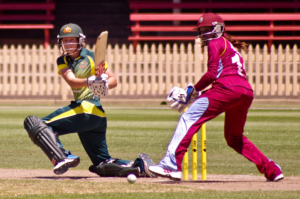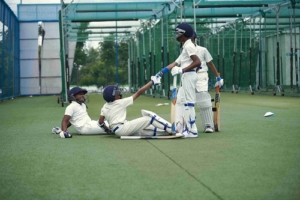
We have often heard the term Dew factor in cricket matches. During the toss time, the commentator always asks the captains about the reason for choosing batting or bowling. Often captains give the reason for the dew factor on the grass.
The dew factor is the only natural reason from which the performances of the players get affected and matches can be turned in anyone’s favour. In this article, we will discuss what is dew factor in Cricket. How does it impact the game? and more.
What is Dew factor in Cricket?
First, let us understand the term Dew. It is a thing which is developed at the earth’s lower temperature making moisture condensed by air. Then it forms on the surface such as grass or leaves.
Now coming to what is dew factor in cricket? If the cricket match is held in the daytime then the dew factor is unlikely to interrupt the performance of the players.
However, if the match is played day or night time then the dew factor is most likely to occur and have an impact on cricket matches.
Since the ground is heated during the daytime of the match. The dew which is formed by the difference in temperature of the ground and air in the stadium is called the dew factor in Cricket.
In addition, the dew factor can be very small or big depending on the weather conditions of the region. The dew factor is largely visible at night time as the temperature goes lower in the evening and the ground is heated.
Often captains prefer chasing during these matches where a dew factor is possible. Bowlers and fielders have very tough times when dew occurs on the ground.
The Impact of Dew Factor in Cricket Game:
The impact of the dew factor in cricket affects various factors. Sometimes the impact of the dew factor in cricket is positive and sometimes it can be a very negative situation.
Here we will evaluate the several factors that are affected or have impacted by the dew factor on the stadium.
Toss Decision:
The most important aspect to affect the game of cricket is the Toss decision. We may think that batting and bowling are the only pivotal aspects that determine the match results.
However, we are very wrong here. Other reasons that affect the game of cricket like outfield slowness, pitch bounce, weather conditions, and the wind direction.
Whenever there is a day-night match the toss decision is often based on the condition of the dew factor in that particular stadium.
Captains have to be very smart in making toss decisions as per the dew factor. Often they decide to bowl first when there is a chance of dew at night.
As the batting conditions improve when the dew comes in the bowlers have a tough time to bowl properly.
However, the results might not be in your favour even when you have decided to chase and not to bat first. The dew factor can work opposite of what you may have thought.
Cricket Ground Pitch:
Though we may think that the dew factor impacts only the grass on the stadium. But the pitch of the stadium is also affected by dew coming into the stadium.
The pitch can be slower with time nearing night time. The moisture due to the dew makes the surface of the pitch fresh.
So there may be a few cracks but it doesn’t get wide. Pitches after the dew comes in get harder for the bowlers to bowl in line and length to batters. Their bowling doesn’t get the momentum and bounce precisely.
Easy Batting Conditions:
One of the positive impacts of Dew is on the batting conditions. With dew coming into the stadiums, the outfield is mandatory.
Hence when you bat the ball seems to outfield and you score a run. Most of the time wet balls give you a run even when you have not played the shot correctly.
As the wet ball tends to travel fast you can score extra runs. Moreover, you can play shots in every direction and there is a high chance of you hitting a boundary.
Challenges Bowlers:
The impact of dew is mostly affected by the bowlers. They have to make extra effort to get their bowling precise in the match. The dew factor challenges bowlers, both fast bowlers and spinners in a different way.
Fast Bowlers:
The fast bowlers have to face a lot of balls getting swung and not going in the length they have bowled to the batters.
As the bowl gets dry and wet at the same time. This makes the ball swing in another direction. Hence, it’s difficult for fast bowlers to get their grip and bowl with the pace correctly.
Spinners:
Even spinners find it difficult to grip with the wet ball. As the spinners are coming in last or middle overs, they get the ball very wet. Hence, they don’t get the turn and grip they require to spin the bowl correctly.
Fielding:
Playing with a wet ball due to dew is tough. Fielders find it hard to hold onto the ball, making it slip away easily. Especially during night matches, catching becomes tricky because of this.
Dew makes the ball slippery, causing fielders to drop catches or make mistakes. To cope, fielders can use towels or gloves to keep their hands dry.
But dew also makes it tough to see clearly, making it hard to judge the ball’s path under stadium lights. Teams need to be extra careful and make sure their players are ready to deal with these challenges when playing in wet conditions.
Impact of Dew Factor on Limited Over Games and Test Matches:
Since the limited overs are mostly played at night time. It is most likely to have zero difference with the dew factor. Both batting and bowling are played during the nighttime.
Coming to the test matches, they are mostly held in the daytime. It might be a 5 or 4-day long match day.
But it all occurs during the daytime. So there is the least chance of test matches being affected by a dew factor.
Earlier few test matches were played during the day-night time but the pink ball usage makes the dew factor fade away. Pink balls are great for having a grip with the dew or without the dew in the cricket stadium.
How to Adapt to the Dew Factor Condition in Cricket?
- The Teams and players, especially captains have to be very strategic with the challenges coming up with the dew factor in the match.
- Captains should look into the dew factor and pitch condition to decide to take the batting or bowling first. They have to be smart with the toss decision.
- Each bowler should be prepared to face the challenges of the dew factor.
- They can reduce the moisture on the ball by the use of towels or rags after every bowl. However, it might take some extra time during each delivery.
- The spinners can be more focused on delivering the bowl that works best on dew to get the batter out.
- Fielding has to be very strong with the help of practice on dew in the stadium.
- Fielders can also dry their hands with a towel to remove the moisture from their hands and have a better grip while catching the ball.
- It is always helpful to chase when the dew factor comes into the stadium.
Conclusion:
The “dew factor” in cricket refers to the moisture that forms on the field during evening matches, affecting how the game is played.
Players often mention it, especially when deciding whether to bowl or bat first. Dew makes the ball wet, making it harder for bowlers to grip and fielders to hold onto the ball. It can benefit the team batting second.
To tackle this issue, cricket authorities could consider using special materials or chemicals in making cricket balls to reduce the impact of dew.
Overall, dew poses challenges, and teams need to adapt their strategies to deal with it during day-night matches.
Being aware of this factor and finding ways to cope with it can significantly influence match outcomes. We hope the query regarding what is dew factor in cricket is resolved now.
Also, check out 3 Ways on How to Hold a Cricket Bat







